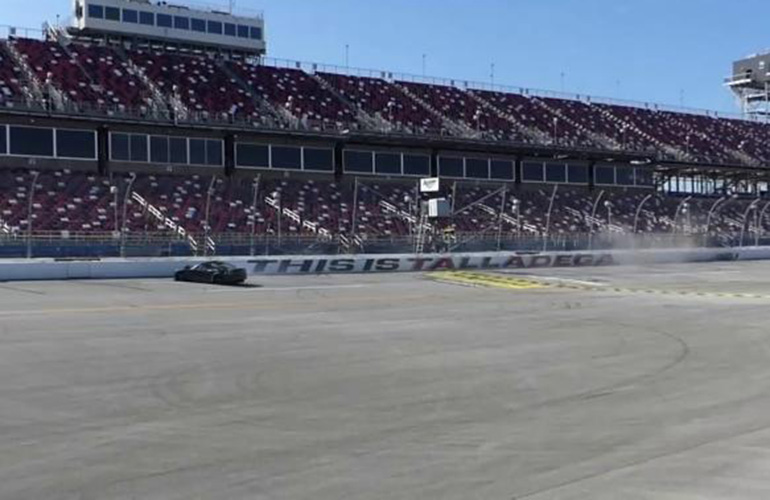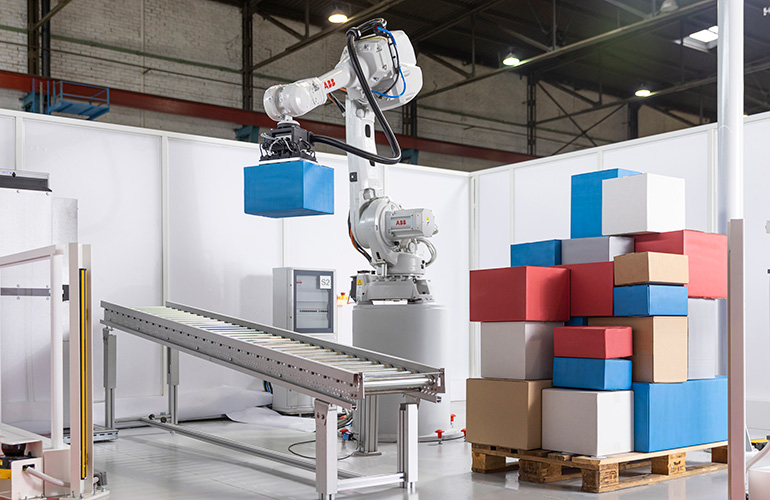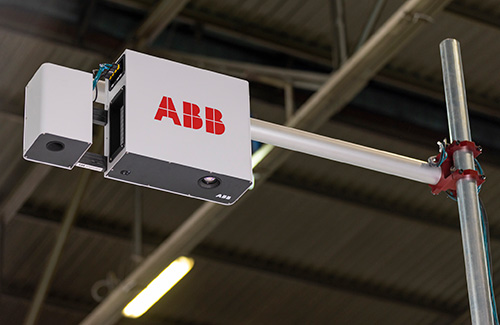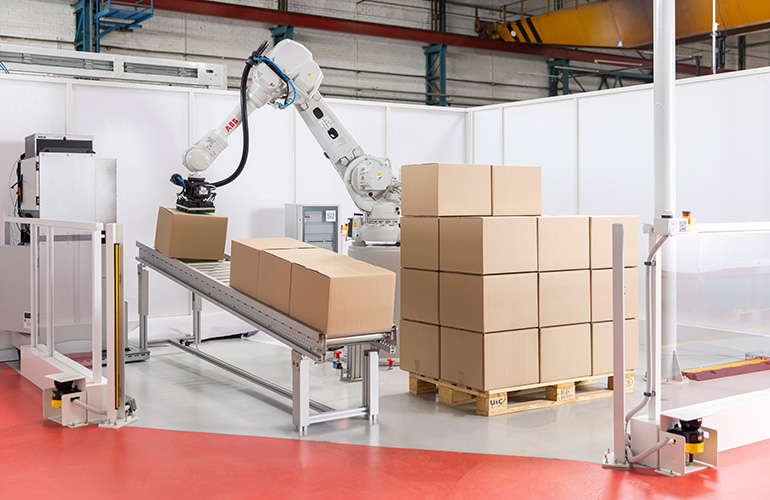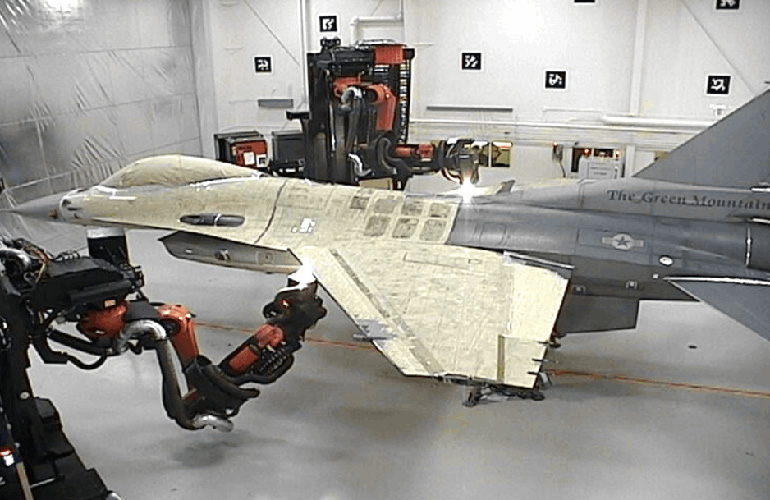
Titan’s robots use lasers to strip the paint from airplanes. | Source: Titan Robotics
The aviation industry is no stranger to automation. The first “gyroscopic automatic pilot” dates back to the earliest days of powered flight. In this century, automation has all but completely transformed the nature of aircraft manufacturing.
In the maintenance hangar, essential safety procedures traditionally relied on the “keen, experienced eyes” of human maintenance personnel. Now, however, automation is gaining ground there as well.
One specific aspect of aircraft maintenance has always posed challenges for human health and safety: the depainting of airplanes. According to Boeing, planes need to have their coatings of paint removed about every five years. Aircraft are painted to prevent corrosion as well as for aesthetic purposes, but periodically, it is important to inspect the plane’s bare surface.
However, aerospace paint typically contains hexavalent chromium. This compound helps to create certain colors and aids in reducing corrosion, but it is also associated with serious health risks. According to the Occupational Health and Safety Administration (OSHA), exposure to hexavalent chromium “can cause severe health effects to workers, including lung cancer.”
This threat has made depainting both dangerous and costly. In the past, every time human workers blasted the paint off an F-16 with hoses spraying plastic beads, the process created no less than a full ton of hazardous waste.
Robotics to the Rescue
With the advent of a new laser-based depainting system from Titan Robotics, it is now possible to execute this essential work with far less risk to human workers.
Based in Pittsburgh, PA, Titan is a spinout from the National Robotics Engineering Center (NREC) at Carnegie Mellon University (CMU). Founded by CMU faculty in 2014, its new approach to aircraft surface processing reflects the success of NREC research funded by the U.S. Air Force.
Laser ablation removes paint from airplanes by “exciting” and vaporizing the molecules. By comparison to blasting or chemical removal methods, this process reduces the production of hazardous waste by more than 90%. Furthermore, Titan’s strong focus on software development has allowed it to develop a system in which robots operate the lasers, keeping humans out of harm’s way.
“We add more complexity and software control on to typical development of automated solutions,’’ noted Alex Klinger, a program engineer at Titan. “With our software, the robots figure out where the plane is, how much paint is on the plane, what type of paint and how to burn the paint off.”
Precision, Mobility, and Safety
To create a 3D map of the surface to be depainted, Titan’s robots use LiDAR (“light detection and ranging”), a sensor technology widely used in autonomous vehicles. In two-robot full aircraft systems, the robots are mounted on mobile bases which allow them to drive themselves around the aircraft. For work on off-aircraft components, rail-based systems allow the robots to reach very long parts of the aircraft. Titan can also design systems in which the robots are fixed in position.
While the robots use continuous wave lasers to remove the paint, humans monitor the process from a control room, where they are protected from exposure.
“It’s really about safety,’’ Klinger said. “They’re really just being the supervisor of the system, making sure it’s doing what it’s supposed to be doing.”
Another critical requirement is the need to maintain the structural integrity of the plane. Damage to the surface of a $130 million fighter jet would be no small matter from a cost point of view. But there is the ultimate priority of flight safety to consider as well.
“There is a tremendous amount of rigor on our side for our control systems and our robotics in making sure that we’re not hitting the aircraft and making sure that our laser processes are not damaging the aircraft,’’ Klinger said.
Connection with Confidence
To guide and protect the power supply and other essential connections such as laser fibers, Titan’s design required specially engineered cable carriers. Manufactured by igus, the triflex system can hold up to 16 cables at a time. One important advantage of triflex is its capacity to handle the weight and protect the cables.
“The weight and the volume are substantial,’’ Klinger said. “I think it’s 12-to-16 distinct cables and they can be held very nicely.”
The other advantage of triflex is the range of motion. “It can hold the cables, but it also has a three-degree freedom of movement,’’ Klinger noted. “A lot of cable chains move in a two-dimensional space, not a three-dimensional space. When you get to complex motions, where a robot is working in three-dimensional space, we need a flexible link that can contain the cables while the robot operates with six degrees of freedom. Triflex can do that.”
Multi-axis cable carriers such as triflex are used in welding, packaging, material handling and automotive applications. A built-in torsion stop reduces mechanical stress on cables, and a defined bend radius ensures the bend radius of cables is not violated.
Klinger noted, “For us, it’s all about having confidence in those cables. We know the product will contain them, will limit how they bend, and it will hold them exactly where we want them to for the entire time.”
New Horizons
The sensing and control methodologies of Titan’s systems have many other potential applications, with the robots deploying different tools. “The robotics are the same, the software is the same,’’ Klinger noted. The cable carriers provided by igus can also solve the same problem in other systems. Regardless of the specific context, it is all about delivering utilities to the point of use. It’s important that we know where those cables are, know that they are protected and not worry about them getting snagged.”
For now, however, Titan Robotics has made a meaningful contribution to the safety of aircraft maintenance personnel. As summed up by Klinger, “you had the human factors of a person working in a terrible environment for a long period of time.’’ Now, with human oversight, robots are helping keep planes safe to fly with far less risk to crews on the ground.
Katherine Bonamo and Thomas Renner write on engineering, construction and other trade industry topics for publications in the United States and Canada.
The post Advanced cable management lets robots depaint airplanes appeared first on The Robot Report.
